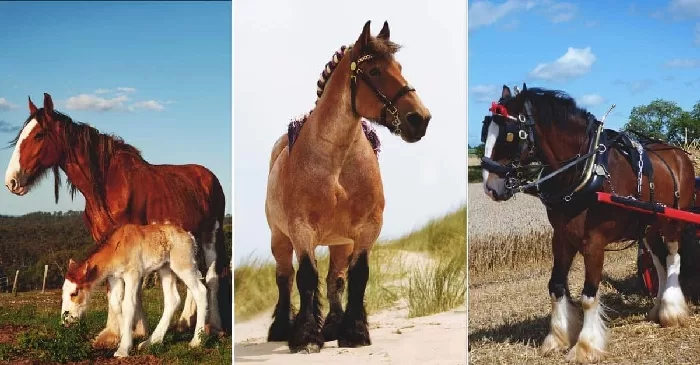However, there are plenty of reasons to switch to work horses on your homestead. Here are some of the best work horses to consider, the top breeds for your homestead, and all the major reasons why you should get started with this old-fashioned skill.
Why You Need a work horse for the Homestead
Work horses aren’t just a thing of the past. After World War II, there were only about 2,000 registered work horses remaining in the country, but starting in the 1970s, a resurgence in their popularity began. Today, small farms everywhere are beginning to slowly re-explore this farm management technique.
But the real attraction of work horses is their size. These powerful creatures can pull more than twice their own weight, something almost unheard of. They are perfect when it comes to tilling and plowing, as well as pulling carts, logs and tractors stuck in mud.
Not all work horses are giants, though. Although most people think of Clydesdales when they think of work horses – these breeds reach 18 hands (one hand equals 4 inches, and hands are measured from the ground to the top of the withers) – there are smaller breeds like Norwegian Fjords that are much smaller, yet still capable of hard labor.
Work horses are ideal for people who want to log the forest or till the field without completely tearing it up and compacting the soil. Because horses have better weight distribution than heavy machinery, they can work more efficiently and with less long term impact on the land. Plus, work horses are more nimble than these pieces of equipment, allowing you to work in harder-to-reach or muddy areas without getting stuck.
Depending on how many work horses you have and how you intend to work with them, you could also use them as an additional income stream. Many small farms are turning to work horses to provide an agritourism component, giving your farm an educational edge that can attract new visitors.
There are plenty of other niche roles that work horses fill, too. They’re easy to ride, exceptionally laid back, and very quick learners. Gentle giants, they are the perfect breed to build confidence in young learner riders.
The Top 10 Breeds to Consider
1. American Cream
The American Cream work horse originated in Iowa in the early 1900s. It’s not the largest work horse you will find, nor is it the smallest. Bred specifically for farm work, this horse has a gorgeous cream coat and amber-colored eyes.
Over 30 breeders actively breed American Creams and are registered with the breed association – but it’s unfortunately been listed as critically threatened by the American Livestock Breeds Conservancy despite its hard-working, easy-going nature.
2. Belgian
3. Clydesdale
These large horses are native to Scotland and are some of the most recognizable breeds. They are usually bay coloured with notable white feathering, but can also be brown, black, roan, and chestnut.
4. Percheron
A French work horse, the Percheron is native to La Perche, just southeast of Normandy. One of the first work horse breeds to come to the United States, the Percheron was the most popular work horse until the Belgian caught up during World War I.
5. Irish Draught
Irish Draught horses were originally bred as dual-purpose horses, participating in weekend hunts and farm work during the week. One of the original and most popular show animals, the Irish Draught is a medium-sized work horse.
Currently, they are very popular for cross-breeding with warmbloods, to create magnificent sporting horses. Due to their slimmer size than other work horses, they are still an excellent option to use on a farm.
6. Shire
The largest draft breed, Shire horses can grow up to 19 hands. Gorgeous horses that are native to England, these horses came to the United States during the mid-1800s. A black horse with white markings, the Shire is becoming more popular on the farm as well as in the show arena.
They have a natural tendency to showiness with their plumed feathers and lively action. Yet despite their size and stature, has a wonderful temperament and grabs attention everywhere they go, plus they make a beautiful tourist attraction when used to pull wagons.
7. Suffolk Punch
8. Brabants
9. Friesians
Native to the Netherlands, the Friesian horse is a graceful, nimble light work horse that has been used as a warhorse in the Middle Ages. With their striking black colour, high-stepping action, and flowing wavey manes and feathers, this is a useful horse to have around the homestead.
Although we are not referring to the Friesian Sporthorse here, which has similar traits, it can also be used under saddle and in harness, as well as in dressage. They are excellent at pulling carts and for recreational driving.
10. Haflingers
A strikingly beautiful horse, Haflingers are large, mild-mannered horses that love to ride. They are sturdy and eager to please and are frequently used in show competitions for umping, far work, and endurance. A typical Haflinger will stand about 15 hands tall and weigh roughly 1,000 lbs, making it one of the smaller work horse breeds.
How to Get Started With work horses
Like all other horses, work horses are not complicated creatures to care for – in fact, if you already have horses on your homestead, there’s not a lot that you will need to do to adjust, except check that your stalls are big enough, doors wide enough, and in some instances – the ceiling is high enough.
work horses require only feed and clean drinking water. You will need to provide them with regular veterinary care and be aware of various potential health issues, too. As with all other horses, work horses need to be part of a well-regimented wellness program that includes regular vaccinations, worming, and lameness monitoring initiatives.
Unlike other types of horses, work horses need a bit more when it comes to their feed, too. The minimum daily caloric requirement for one of these creatures is at least 10,000 calories for every 1,000 lbs of body fat. work horses need more fat than other types of horses, so you will need to supplement the typical diet of hay and horse feed with a pound of fat each day.
Due to their large size, their feet need to be diligently checked and training for shoeing should be done from an early age, as these large plate-sized hooves do require a little more TLC than your average horse.
Knowing how to care for a work horse depends largely on each breed’s individual needs. Some medical issues are specific to work horses, such as Equine Polysaccharide Storage Myopathy. This condition causes muscle fiber to atrophy as a result of the body’s inability to metabolize starches. Luckily, this is a condition that’s easily managed through diet.
At the end of the day, caring for a work horse comes down to being attentive to your individual horse’s needs and abilities.
Tips for Working with work horses
Any size or breed of a work horse can be useful on your homestead, but it’s helpful to have a clear idea of what work that needs to be done before you invest in a work horse.
Always engage in a great deal of training before you set off on your own. Working with an experienced teamster is the best way to do this, as he or she can teach you the ins and outs of working with these animals.
It’s best to exercise caution in the beginning, too, particularly if you are working with a young or inexperienced team. Avoid doing too much work on rocky or steep ground, as this can injure your horses.
The more you work with your horses, the better you will work together. As intelligent animals, they will bond quickly with you. However, you need to do your fair share of caring for them too.
Watch out for the potential health issues that your breed is prone to, and inspect your animals daily for signs of injury or illness. Provide your work horses with a properly fitting harness and make sure they only pull well-maintained equipment, as lugging faulty equipment can cause muscle and painful skin damage.
work horses also have a more difficult time controlling their own body temperatures during the hot summer months. Because they are more muscular than other types of horses, they produce more heat – they like cold weather much more. Make sure you have a shady area on your property, either in the barn or the pasture, where they can cool off. In addition, you should not work them in extreme heat.
Buying Your First work horse Team
Again, don’t even think about purchasing or working with your team until you actually know what you are doing! However, once you’ve learned the ropes, you can start shopping.
Select the breed that will mesh the best with the work you want (or need) to get done on your farm or in your business. Always carefully inspect the hooves of your horses before bringing them home, as this will give you an idea of their overall health.
Avoid the temptation of buying a horse at auction. Often, horses are drugged before the show to make them seem docile. You might not be getting the value you think you are! Otherwise, the price of a work horse varies drastically. Registered work horses will cost more, often in excess of $5,000.
If you’re new to work horse work, you might want to consider buying an older team that has been trained well with an experienced teamster. This way, the learning curve will be only your responsibility – and you will have an easier time figuring things out for yourself.
The only downside to using work horses as an alternative to your trusted tractor or skidder? You’re going to have to feed them – and we don’t remember ever having to buy grain for a skidder!
Source: Morning Chores












